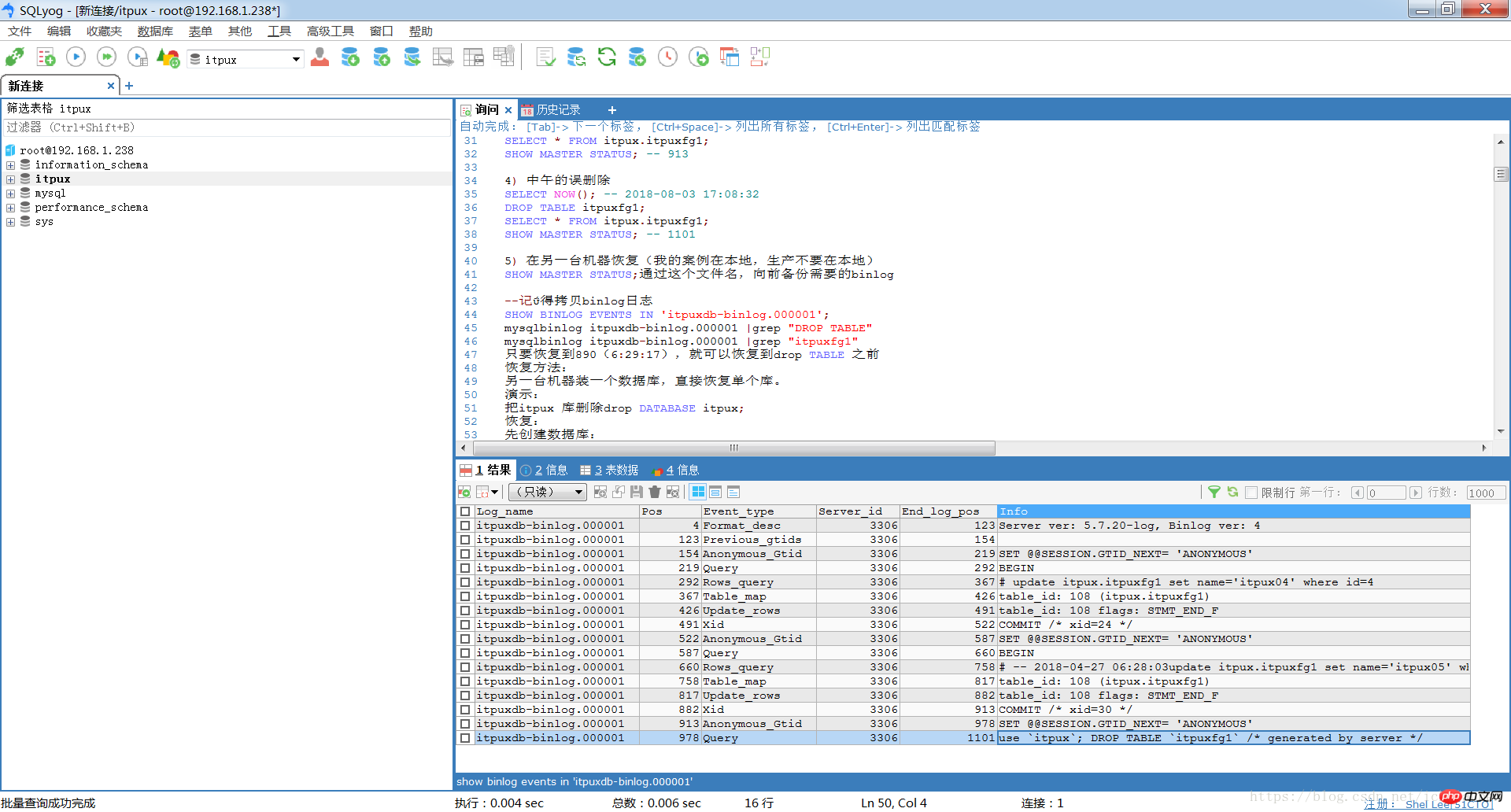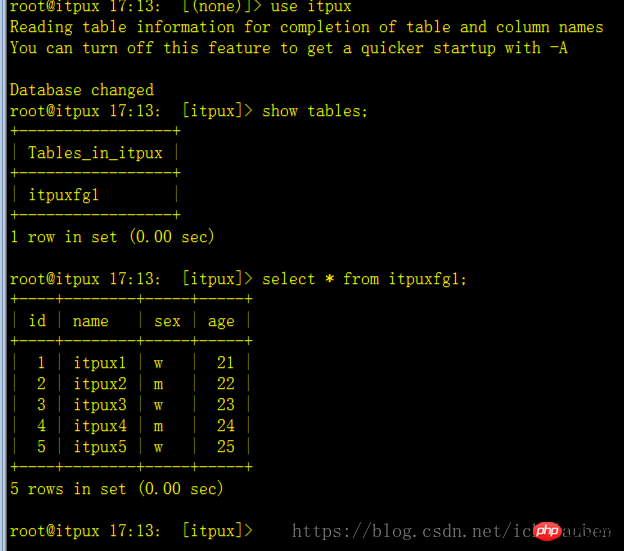 Database
Database
 Mysql Tutorial
Mysql Tutorial
 Mysql combines backup + binlog to restore accidentally deleted operation data
Mysql combines backup + binlog to restore accidentally deleted operation data
Mysql combines backup + binlog to restore accidentally deleted operation data
Recover data by combining the backup binlog.
Scenario: After making all preparations last night, the user accidentally deleted a table this morning.
Solution: It is not recommended to restore directly in the original production environment. It is recommended to restore the entire database log on another machine and then import it into the production environment.

1) Create table
select now(); create table itpuxfg1 ( `id` int(10) unsigned not null auto_increment, `name` varchar(16) not null, `sex` enum('m','w') not null default 'm', `age` tinyint(3) unsigned not null, primary key (`id`) ) engine=innodb default charset=utf8; insert into itpux.itpuxfg1(`name`,`sex`,`age`) values ('itpux1','w',21), ('itpux2','m',22), ('itpux3','w',23), ('itpux4','m',24), ('itpux5','w',25); commit; select * from itpux.itpuxfg1;
2) Make backup logical backup
mysqldump -uroot -p -F -R --all-databases > alldb_bak.sql
3) Simulate business operations in the morning
show master status; -- 154 select now(); -- 2018-04-27 06:27:40 update itpux.itpuxfg1 set name='itpux04' where id=4; commit; select * from itpux.itpuxfg1; select now(); -- 2018-04-27 06:28:03 update itpux.itpuxfg1 set name='itpux05' where id=5; commit; select * from itpux.itpuxfg1; show master status; -- 890
4) Accidental deletion at noon
select now(); -- 2018-04-27 06:29:00 drop table itpuxfg1; select * from itpux.itpuxfg1; show master status; -- 1078
5) Restore on another machine (in my case, it is local, production should not be local)
show master status;pass This file name is the binlog required for forward backup
--remember to copy the binlog log
show binlog events in 'itpuxdb-binlog.000003';
mysqlbinlog itpuxdb-binlog .000003 |grep "DROP TABLE"
mysqlbinlog itpuxdb-binlog.000003 |grep "itpuxfg1" (Please distinguish between two different versions of the log)


Demo:
Delete the itpux library drop database itpux;
Restore:
Create the database first:
mysql> create database itpux default character set utf8; -- If the conditions are not clear, it is recommended to query the original database show create database mysql;
mysql -uroot -p - o itpux
-- After recovery, the records updated this morning cannot be found
mysql> show tables;

How to restore mysql deleted database without backup
MySQL replication snapshot recovery accidental deletion operation experimental test
The above is the detailed content of Mysql combines backup + binlog to restore accidentally deleted operation data. For more information, please follow other related articles on the PHP Chinese website!

Hot AI Tools

Undresser.AI Undress
AI-powered app for creating realistic nude photos

AI Clothes Remover
Online AI tool for removing clothes from photos.

Undress AI Tool
Undress images for free

Clothoff.io
AI clothes remover

Video Face Swap
Swap faces in any video effortlessly with our completely free AI face swap tool!

Hot Article

Hot Tools

Notepad++7.3.1
Easy-to-use and free code editor

SublimeText3 Chinese version
Chinese version, very easy to use

Zend Studio 13.0.1
Powerful PHP integrated development environment

Dreamweaver CS6
Visual web development tools

SublimeText3 Mac version
God-level code editing software (SublimeText3)

Hot Topics
 1387
1387
 52
52
 When might a full table scan be faster than using an index in MySQL?
Apr 09, 2025 am 12:05 AM
When might a full table scan be faster than using an index in MySQL?
Apr 09, 2025 am 12:05 AM
Full table scanning may be faster in MySQL than using indexes. Specific cases include: 1) the data volume is small; 2) when the query returns a large amount of data; 3) when the index column is not highly selective; 4) when the complex query. By analyzing query plans, optimizing indexes, avoiding over-index and regularly maintaining tables, you can make the best choices in practical applications.
 Can I install mysql on Windows 7
Apr 08, 2025 pm 03:21 PM
Can I install mysql on Windows 7
Apr 08, 2025 pm 03:21 PM
Yes, MySQL can be installed on Windows 7, and although Microsoft has stopped supporting Windows 7, MySQL is still compatible with it. However, the following points should be noted during the installation process: Download the MySQL installer for Windows. Select the appropriate version of MySQL (community or enterprise). Select the appropriate installation directory and character set during the installation process. Set the root user password and keep it properly. Connect to the database for testing. Note the compatibility and security issues on Windows 7, and it is recommended to upgrade to a supported operating system.
 Explain InnoDB Full-Text Search capabilities.
Apr 02, 2025 pm 06:09 PM
Explain InnoDB Full-Text Search capabilities.
Apr 02, 2025 pm 06:09 PM
InnoDB's full-text search capabilities are very powerful, which can significantly improve database query efficiency and ability to process large amounts of text data. 1) InnoDB implements full-text search through inverted indexing, supporting basic and advanced search queries. 2) Use MATCH and AGAINST keywords to search, support Boolean mode and phrase search. 3) Optimization methods include using word segmentation technology, periodic rebuilding of indexes and adjusting cache size to improve performance and accuracy.
 Difference between clustered index and non-clustered index (secondary index) in InnoDB.
Apr 02, 2025 pm 06:25 PM
Difference between clustered index and non-clustered index (secondary index) in InnoDB.
Apr 02, 2025 pm 06:25 PM
The difference between clustered index and non-clustered index is: 1. Clustered index stores data rows in the index structure, which is suitable for querying by primary key and range. 2. The non-clustered index stores index key values and pointers to data rows, and is suitable for non-primary key column queries.
 What are some popular MySQL GUI tools (e.g., MySQL Workbench, phpMyAdmin)?
Mar 21, 2025 pm 06:28 PM
What are some popular MySQL GUI tools (e.g., MySQL Workbench, phpMyAdmin)?
Mar 21, 2025 pm 06:28 PM
Article discusses popular MySQL GUI tools like MySQL Workbench and phpMyAdmin, comparing their features and suitability for beginners and advanced users.[159 characters]
 How do you handle large datasets in MySQL?
Mar 21, 2025 pm 12:15 PM
How do you handle large datasets in MySQL?
Mar 21, 2025 pm 12:15 PM
Article discusses strategies for handling large datasets in MySQL, including partitioning, sharding, indexing, and query optimization.
 MySQL: Simple Concepts for Easy Learning
Apr 10, 2025 am 09:29 AM
MySQL: Simple Concepts for Easy Learning
Apr 10, 2025 am 09:29 AM
MySQL is an open source relational database management system. 1) Create database and tables: Use the CREATEDATABASE and CREATETABLE commands. 2) Basic operations: INSERT, UPDATE, DELETE and SELECT. 3) Advanced operations: JOIN, subquery and transaction processing. 4) Debugging skills: Check syntax, data type and permissions. 5) Optimization suggestions: Use indexes, avoid SELECT* and use transactions.
 The relationship between mysql user and database
Apr 08, 2025 pm 07:15 PM
The relationship between mysql user and database
Apr 08, 2025 pm 07:15 PM
In MySQL database, the relationship between the user and the database is defined by permissions and tables. The user has a username and password to access the database. Permissions are granted through the GRANT command, while the table is created by the CREATE TABLE command. To establish a relationship between a user and a database, you need to create a database, create a user, and then grant permissions.



